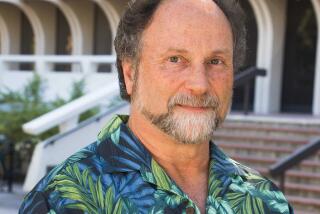A newspaper asks whether taxes are applied to golf courses in a fair way
Stepping into that old building on 9th Street downtown, I half expected to find Philip Marlowe inside.
Maybe it was the ample marble in the 1920s lobby that took me back to that old L.A. The musty hallways and the oak doors with frosted-glass windows made me feel I had walked into a Raymond Chandler novel.
Jerry Sullivan was the man I’d come to see, and he even looked a bit like Chandler’s private eye. He had a fedora on his head, polished black shoes on his feet, and a smartly pressed wool suit on his long frame.
When he talked, he sounded as hard-boiled as Marlowe too.
“I took a look at this, and I said, ‘Something’s not right here,’ ” Sullivan told me. “Sometimes, you have to ask the impertinent question.”
Sullivan runs a little weekly newspaper called the Los Angeles Garment & Citizen. What didn’t look “right” to him involved some of L.A. County’s richest country clubs and that complicated bit of California law known as Proposition 13.
Last month, Sullivan’s paper reported that exclusive golf courses like the Bel-Air Country Club -- where new memberships can cost tens of thousands of dollars -- have been protected by Prop. 13 for decades.
It’s the clubs’ unique ownership structure that may -- or may not -- allow them to pay lower taxes.
No one, it seems, had ever really asked Los Angeles County officials whether the exclusive golf courses really should have the same protection as homeowners. So most of the country clubs have been paying low rates for 30 years.
“It seemed unbalanced,” Sullivan told me. “We’ve got a state with a $21-billion deficit. . . . I believe in property rights, but there’s also some freight to pay with being a property owner.”
I’m not surprised it took a journalistic outsider like Sullivan to bring the story to light. Like Chandler, he has a nose for complicated tales that expose the hidden privileges of wealth and power.
Most property in California can’t be reassessed to reflect changing market values until it’s sold. Because residential property changes hands more frequently than the tradition-bound country clubs, the clubs’ tax deal looks sweeter with each passing year.
As my colleague Alexandra Zavis reported Saturday, the 128-acre Brentwood Country Club, with its 18-hole golf course, tennis courts and other facilities, is paying significantly less tax than either of two six-bedroom homes just down the street.
That’s clearly unfair. Or, as Chandler might have put it: The whole story smells bad. Like fruit rotting sweetly in the California sunshine.
Sullivan’s Garment & Citizen has a circulation of 10,000. Unless you live or work close to downtown, chances are you’ve never seen it.
But its story on the country clubs, written by freelancer Benjamin Mark Cole, has already had an impact.
Presented with the Garment & Citizen’s questions, Los Angeles County Tax Assessor Rich Auerbach said he didn’t know if the clubs were entitled to Prop. 13 protection.
No one had ever asked about the clubs’ ownership structure, Auerbach told The Times. “It is still somewhat hard to understand how this has not come up before,” the assessor said.
Thanks to the Garment & Citizen, Auerbach has now referred the matter to the State Board of Equalization for review.
I was a 15-year-old L.A. news junkie when Howard Jarvis was touting Prop. 13 up and down the state in 1978.
I remember Jarvis saying it was outrageous that homeowners’ taxes were going up so much every year.
I also remember my teachers saying that Prop. 13 would be a disaster for public education.
But I don’t remember anyone saying we ought to give country clubs a tax break.
I called Lenny Goldberg at the California Tax Reform Assn., a watchdog group, to see if he could explain how this happened.
Goldberg said commercial property got a sweet deal in the legislative negotiations that followed Prop. 13’s passage. The Legislature adopted a business-friendly definition of “change in ownership” when writing the rules that applied Prop 13 to commercial property.
“The law just doesn’t reflect the complex forms of commercial ownership we see in the real world,” Goldberg told me.
Most country clubs are, in fact, organized as “equity clubs.” Individuals buy memberships, which are akin to shares. The Garment & Citizen’s stories asked if the ever-changing membership lists don’t, in fact, constitute changes of ownership.
Sullivan dedicated the bulk of his Dec. 18 issue to explaining the tax rules and the assessor’s response to his paper’s queries. It wasn’t his first scoop. Last year, he argued that Los Angeles parks officials were paying too much to purchase a small parcel on Spring Street.
City officials eventually reduced their offer from $5.6 million to $5.1 million.
“To quote Orwell,” Sullivan told me, “sometimes the first duty of an intelligent person is the restatement of the obvious.”
Sullivan, 48, is a veteran L.A. business reporter who said he founded the Garment & Citizen 10 years ago largely “out of my pocket.”
These days he’s got one paid employee and his office -- “one and a half rooms . . . in the back of a building” -- matches Chandler’s description of Marlowe’s.
Sometimes it’s hard for the Garment & Citizen to get noticed. Cole told me he e-mailed the assessor for months before getting an interview. He sent a few e-mails to the country clubs too, without response.
When I called the Bel-Air Country Club, the operator put me through to someone’s voice mail. I wanted to ask if they thought it was fair that the club’s spectacular 120-acre property was assessed at just $5.7 million last year.
A couple of days later I got a call from Bob Bouchier, a director of the California State Club Assn., an industry group.
Bouchier told me the clubs pay lower property taxes not just because of Prop. 13, but also because their fairways and sand traps are “green space” that improves our quality of life.
Even if I couldn’t play golf there myself, Bouchier argued, the land provides “habitat” for wildlife and other benefits.
Over the weekend I rolled out to Bel-Air to see if I might, like a migrating bird, breathe in a bit of green space.
Marlowe visits Bel-Air in “The Tall Window.” “There was a drowsy smell of flowers and sun,” Chandler wrote, “a swishing of lawn sprinklers gentle behind hedges and walls.”
Not much has changed.
Reaching the Bel-Air Country Club, I drove past signs that said “private” and “members and guests only.”
I reached a valet who examined the inside of my car the way a customs official studies a suspicious package. He said I’d have to leave.
I drove back home, studied my property tax bill and felt more than a little ripped off.
More to Read
Sign up for Essential California
The most important California stories and recommendations in your inbox every morning.
You may occasionally receive promotional content from the Los Angeles Times.











